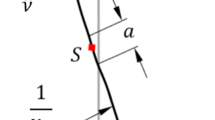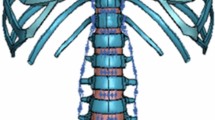Abstract
Load–displacement relationships of spinal motion segments are crucial factors in characterizing the stiffness of scoliotic spine models to mimic the spine responses to loads. Although nonlinear approach to approximation of the relationships can be superior to linear ones, little mention has been made to deriving personalized nonlinear load–displacement relationships in previous studies. A method is developed for nonlinear approximation of load–displacement relationships of spinal motion segments to assist characterizing in vivo the stiffness of spine models. We propose approximation by tangent functions and focus on rotational displacements in lateral direction. The tangent functions are characterized using lateral bending test. A multi-body model was characterized to 18 patients and utilized to simulate four spine positions; right bending, left bending, neutral, and traction. The same was done using linear functions to assess the performance of the proposed tangent function in comparison with the linear function. Root-mean-square error (RMSE) of the displacements estimated by the tangent functions was 44 % smaller than the linear functions. This shows the ability of our tangent function in approximation of the relationships for a range of infinitesimal to large displacements involved in the spine movement to the four positions. In addition, the models based on the tangent functions yielded 67, 55, and 39 % smaller RMSEs of Ferguson angles, locations of vertebrae, and orientations of vertebrae, respectively, implying better estimates of spine responses to loads. Overall, it can be concluded that our method for approximating load–displacement relationships of spinal motion segments can offer good estimates of scoliotic spine stiffness.







Similar content being viewed by others
Notes
In multi-body models of the scoliotic spine, to simulate the lateral bending positions, a force is typically exerted on the uppermost vertebra in the spine model in the erect position [12].
504 displacements = 14 vertebrae from L3 to T2 × 2 positions × 18 patients; note that L4 had no displacement according to definition of G.
The bending X-rays are taken while the patients perform maximum voluntary bending movements to the right/left sides, implying small difference between R and r.
References
Abouhossein A, Weisse B, Ferguson SJ (2011) A multibody modelling approach to determine load sharing between passive elements of the lumbar spine. Comput Methods Biomech Biomed Eng 14:527–537
Asher MA, Burton DC (2006) Adolescent idiopathic scoliosis: natural history and long term treatment effects. Scoliosis 1:2
Ashton-Miller JA, Schultz AB (1987) Biomechanics of the human spine and trunk. Exerc Sport Sci Rev 16:169–204
Aubin C-E, Petit Y, Stokes I, Poulin F, Gardner-Morse M, Labelle H (2003) Biomechanical modeling of posterior instrumentation of the scoliotic spine. Comput Methods Biomech Biomed Eng 6:27–32
Aubin CE, Labelle H, Chevrefils C, Desroches G, Clin J, Eng ABM (2008) Preoperative planning simulator for spinal deformity surgeries. Spine 33:2143–2152
Bazrgari B, Shirazi-Adl A, Arjmand N (2007) Analysis of squat and stoop dynamic liftings: muscle forces and internal spinal loads. Eur Spine J 16:687–699
Chalmers E, Westover L, Jacob J, Donauer A, Zhao V, Parent E, Moreau M, Mahood J, Hedden D, Lou EM (2015) Predicting success or failure of brace treatment for adolescents with idiopathic scoliosis. Med Biol Eng Computt 53:1001–1009. doi:10.1007/s11517-015-1306-7
Cheriet F, Meunier J (1999) Self-calibration of a biplane X-ray imaging system for an optimal three dimensional reconstruction. Comput Med Imaging Graph 23:133–141
Christophy M, Curtin M, Senan NAF, Lotz JC, O’Reilly OM (2013) On the modeling of the intervertebral joint in multibody models for the spine. Multibody SysDyn 30:413–432
Christophy M, Senan NAF, Lotz JC, O’Reilly OM (2012) A musculoskeletal model for the lumbar spine. Biomech Model Mechanobiol 11:19–34
Colton T (1974) Statistics in medicine. Little, Brown, Boston, p 164
Desroches G, Aubin C-E, Sucato DJ, Rivard C-H (2007) Simulation of an anterior spine instrumentation in adolescent idiopathic scoliosis using a flexible multi-body model. Med Biol Eng Comput 45:759–768
Duke K, Aubin C-E, Dansereau J, Labelle H (2005) Biomechanical simulations of scoliotic spine correction due to prone position and anaesthesia prior to surgical instrumentation. Clin Biomech 20:923–931
Engsberg JR, Lenke LG, Reitenbach AK, Hollander KW, Bridwell KH, Blanke K (2002) Prospective evaluation of trunk range of motion in adolescents with idiopathic scoliosis undergoing spinal fusion surgery. Spine 27:1346–1354
Gardner-Morse MG, Stokes IA (2004) Structural behavior of human lumbar spinal motion segments. J Biomech 37:205–212
Heuer F, Schmidt H, Klezl Z, Claes L, Wilke H-J (2007) Stepwise reduction of functional spinal structures increase range of motion and change lordosis angle. J Biomech 40:271–280
Huynh K, Gibson I, Jagdish B, Lu W (2015) Development and validation of a discretised multi-body spine model in LifeMOD for biodynamic behaviour simulation. Comput Methods Biomech Biomed Eng 18:175–184
Jalalian A, Gibson I, Tay EH (2013) Computational biomechanical modeling of scoliotic spine: challenges and opportunities. Spine Deform 1:401–411
Jalalian A, Tay EH, Arastehfar S, Gibson I, Liu G (2016) Finding line of action of the force exerted on erect spine based on lateral bending test in personalization of scoliotic spine models. Med Biol Eng Comput. doi:10.1007/s11517-016-1550-5
Jalalian A, Tay EH, Arastehfar S, Liu G (2016) A patient-specific multibody kinematic model for representation of the scoliotic spine movement in frontal plane of the human body. Multibody Syst Dyn
Jalalian A, Tay EH, Liu G (2016) Data mining in medicine: relationship of scoliotic spine curvature to the movement sequence of lateral bending positions. In: 15th industrial conference on data mining ICDM 2016, New York, USA, 12–14 July 2016. Springer International Publishing, pp 29–40
Jalalian A, Tay EH, Liu G A hypothesis about line of action of the force exerted on spine based on lateral bending test in personalized scoliotic spine models. In: The Canadian society for mechanical engineering international congress, Kelowna, BC, Canada, June 26–29, 2016
Keenan BE, Izatt MT, Askin GN, Labrom RD, Pettet GJ, Pearcy MJ, Adam CJ (2014) Segmental torso masses in adolescent idiopathic scoliosis. Clin Biomech 29:773–779
Klepps SJ, Lenke LG, Bridwell KH, Bassett GS, Whorton J (2001) Prospective comparison of flexibility radiographs in adolescent idiopathic scoliosis. Spine 26:E74–E79
Little JP, Adam C (2011) Patient-specific computational biomechanics for simulating adolescent scoliosis surgery: predicted vs clinical correction for a preliminary series of six patients. Int J Numer Methods Biomed Eng 27:347–356
McGill SM, Norman RW (1987) Effects of an anatomically detailed erector spinae model on L4L5 disc compression and shear. J Biomech 20:591–600
O’Reilly OM, Metzger MF, Buckley JM, Moody DA, Lotz JC (2009) On the stiffness matrix of the intervertebral joint: application to total disk replacement. J Biomech Eng 131:081007
Oxland TR, Lin RM, Panjabi MM (1992) Three-dimensional mechanical properties of the thoracolumbar junction. J Orthop Res 10:573–580
Panjabi MM, Brand RA Jr, White AA III (1976) Three-dimensional flexibility and stiffness properties of the human thoracic spine. J Biomech 9:185–192
Panjabi MM, Oxland T, Yamamoto I, Crisco J (1994) Mechanical behavior of the human lumbar and lumbosacral spine as shown by three-dimensional load-displacement curves. J Bone Joint Surg 76:413–424
Perret C, Poiraudeau S, Fermanian J, Revel M (2001) Pelvic mobility when bending forward in standing position: validity and reliability of 2 motion analysis devices. Arch Phys Med Rehabil 82:221–226
Petit Y, Aubin C, Labelle H (2004) Patient-specific mechanical properties of a flexible multi-body model of the scoliotic spine. Med Biol Eng Comput 42:55–60
Polly DW Jr, Sturm PF (1998) Traction versus supine side bending: which technique best determines curve flexibility? Spine 23:804–808
Rupp T, Ehlers W, Karajan N, Günther M, Schmitt S (2015) A forward dynamics simulation of human lumbar spine flexion predicting the load sharing of intervertebral discs, ligaments, and muscles. Biomech Model Mechanobiol 14:1081–1105
Salmingo RA, Tadano S, Fujisaki K, Abe Y, Ito M (2013) Relationship of forces acting on implant rods and degree of scoliosis correction. Clin Biomech 28:122–128
Shojaei I, Arjmand N, Bazrgari B (2015) An optimization‐based method for prediction of lumbar spine segmental kinematics from the measurements of thorax and pelvic kinematics. Int J Numer Methods Biomed Eng 31(12). doi:10.1002/cnm.2729
Stokes I, Iatridis J (2005) Biomechanics of the spine. In: Mow VC, Huiskes R (eds) Basic orthopaedic biomechanics and mechano-biology. Lippincott Williams, Wilkins, Philadelphia, pp 196–197
Stokes IA (1994) Three-dimensional terminology of spinal deformity: a report presented to the scoliosis research society by the scoliosis research society working group on 3-D terminology of spinal deformity. Spine 19:236–248
Stokes IA, Gardner-Morse M, Churchill D, Laible JP (2002) Measurement of a spinal motion segment stiffness matrix. J Biomech 35:517–521
Three-Dimensional Terminology of Spinal Deformity (2001) Scoliosis research society. http://www.srs.org/professionals/glossary/SRS_3D_terminology.htm-1. Accessed 29 Dec 2014
Udoekwere UI, Krzak JJ, Graf A, Hassani S, Tarima S, Riordan M, Sturm PF, Hammerberg KW, Gupta P, Anissipour AK (2014) Effect of lowest instrumented vertebra on trunk mobility in patients with adolescent idiopathic scoliosis undergoing a posterior spinal fusion. Spine Deformity 2:291–300
Wagnac E, Arnoux P-J, Garo A, Aubin C-E (2012) Finite element analysis of the influence of loading rate on a model of the full lumbar spine under dynamic loading conditions. Med Biol Eng Comput 50:903–915. doi:10.1007/s11517-012-0908-6
Wong KW, Leong JC, M-k Chan, Luk KD, Lu WW (2004) The flexion–extension profile of lumbar spine in 100 healthy volunteers. Spine 29:1636–1641
Author information
Authors and Affiliations
Corresponding author
Appendix
Appendix
Period of tangent functions is influential to the fitting of such a function to data. The catch is that the data may not show where the vertical asymptotes will fall precisely, and thus, the period cannot be identified directly. To estimate the asymptotes, the range of the available data on the horizontal axis is considered as the initial value for the period of the tangent, and then, both sides of the range are extended until the best fitting is achieved. In our case, the rotational displacements from the erect to right/left bending positions are considered as the initial value for the period. This traces back to the fact that the patients perform maximum voluntary bending movements to the right/left sides, implying that the vertebrae may rotate almost as much as their displacement limits (the vertical asymptotes). Therefore, to identify R Right/Left, we studied the discrepancy between the fitted tangent functions and the displacement data acquired from the lateral bending X-rays against the extension to [r Right, r Left] of the vertebrae (Fig. 8). To do the study, the minimization problem expressed by (5) was solved for 0, 10, 20, 30, and 40 % enlargements of r Right/Left. According to RMSEs plotted in Fig. 8, the enlargement by 20 % resulted in the smallest discrepancies among the considered enlargement percentages. Therefore, R Right/Left was estimated by 1.2 × r Right/Left.
Rights and permissions
About this article
Cite this article
Jalalian, A., Tay, F.E.H., Arastehfar, S. et al. A new method to approximate load–displacement relationships of spinal motion segments for patient-specific multi-body models of scoliotic spine. Med Biol Eng Comput 55, 1039–1050 (2017). https://doi.org/10.1007/s11517-016-1576-8
Received:
Accepted:
Published:
Issue Date:
DOI: https://doi.org/10.1007/s11517-016-1576-8





